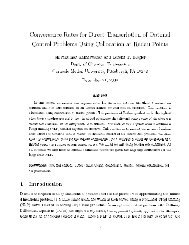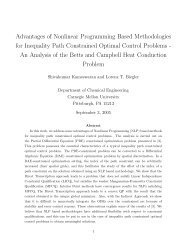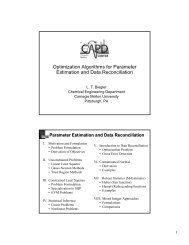MPEC Problem Formulations in Chemical Engineering Applications
MPEC Problem Formulations in Chemical Engineering Applications
MPEC Problem Formulations in Chemical Engineering Applications
You also want an ePaper? Increase the reach of your titles
YUMPU automatically turns print PDFs into web optimized ePapers that Google loves.
[18] Mittelmann, H.D. and A. Pruessner, “A Server for Automated PerformanceAnalysis of Benchmark<strong>in</strong>g Data”, Optimization Methods and Software, 21,1, pp. 105-120 (2006).[19] <strong>MPEC</strong> Library, http://www.gamsworld.eu/mpec/mpeclib.htm[20] Raghunathan, A. and L. T. Biegler, “<strong>MPEC</strong> <strong>Formulations</strong> and Algorithms<strong>in</strong> Process Eng<strong>in</strong>eer<strong>in</strong>g,” Computers and <strong>Chemical</strong> Eng<strong>in</strong>eer<strong>in</strong>g, 27, pp.1381-1392 (2003)[21] Raghunathan, A., PhD Thesis, Department of <strong>Chemical</strong> Eng<strong>in</strong>eer<strong>in</strong>g,Carnegie Mellon University (2004)[22] Raghunathan, A.U. and L.T. Biegler, “Interior po<strong>in</strong>t methods for MathematicalPrograms with Complementarity Constra<strong>in</strong>ts (MPCCs),” SIAM J.Optimization, 15, 3, pp. 720-750 (2005)[23] Raghunathan, A., M.S. Diaz, L.T. Biegler “An <strong>MPEC</strong> Formulation for DynamicOptimization of Distillation Operation,” Computers and <strong>Chemical</strong>Eng<strong>in</strong>eer<strong>in</strong>g, 28/10 pp. 2037-2052 (2004)[24] Ralph, D. and S. J. Wright, “Some Properties of Regularization and PenalizationSchemes for <strong>MPEC</strong>s,” Optimization Methods and Software, 19,5, pp. 527-556 (2004)[25] Poku, M., L. Biegler, and D. Ternet, Real-Time Optimization (RTO) Onl<strong>in</strong>eTool - ROMeo & IPOPT, PREPRINT, 2005.[26] Scheel, H. and S. Scholtes, “Mathematical Programs with ComplementarityConstra<strong>in</strong>ts: Stationarity, Optimality, and Sensitivity,” Mathematics ofOperations Research, 25, 1, (2000)[27] Scholtes, S. and M. Stöhr, “How Str<strong>in</strong>gent is the L<strong>in</strong>ear Independence Assumptionfor Mathematical Programs with Complementarity Constra<strong>in</strong>ts?”Mathematics of Operations Research, 26, 4, pp. 851-863 (2001).[28] Ste<strong>in</strong>, O., J. Oldenburg, W. Marquardt, “Cont<strong>in</strong>uous Reformulations ofDiscrete-Cont<strong>in</strong>uous Optimization <strong>Problem</strong>s,” Computers & <strong>Chemical</strong> Eng<strong>in</strong>eer<strong>in</strong>g,Vol. 28, No. 10, 2004, 1951 - 1966[29] Stewart, D. and M. Anitescu “Optimal Control of Systems with Discont<strong>in</strong>uousDifferential Equations,” Prepr<strong>in</strong>t number: ANL/MCS-P1258-0605,Mathematics and Computer Science Division, Argonne National Laboratory,June 2005.[30] Young, J.C.C., R. Baker, and C.L.E. Swartz, “Input saturation effects <strong>in</strong>optimiz<strong>in</strong>g control: <strong>in</strong>clusion with<strong>in</strong> a simultaneous optimization framework,”Computers and <strong>Chemical</strong> Eng<strong>in</strong>eer<strong>in</strong>g, 28, pp. 1347-1360 (2004)28






